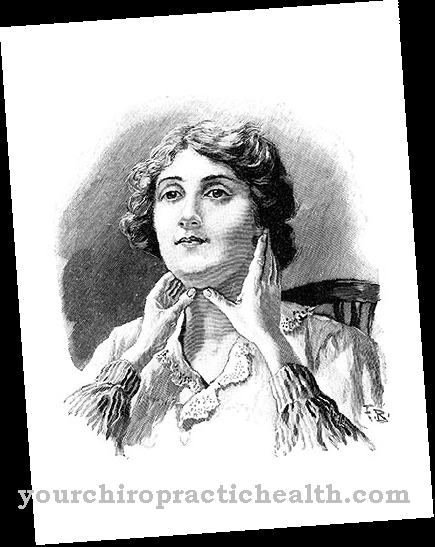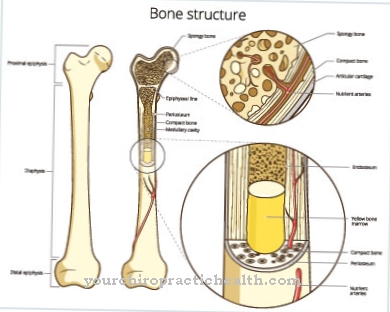A Dystonia is a long lasting muscle contraction that cannot be consciously controlled. It can occur regardless of a person's age. Therapeutic approaches for treating symptoms are based on the form of dystonia and the symptoms of a person affected.
What is dystonia?

© adimas - stock.adobe.com
Dystonia is a nerve disorder that is characterized by involuntary (not controlled by the will to control) muscle contractions in the person affected. Which muscles are affected by dystonia differs depending on the individual case:
If there is so-called generalized dystonia, the muscles of the whole body or a large part of the body can be affected by muscle contractions. What is known as focal dystonia, on the other hand, usually only affects individual muscle groups.
Muscle contractions in the context of dystonia can manifest themselves, for example, through certain movements of the person affected or through changes in posture. Dystonia can occur in people of any age; Generalized dystonia often begins in childhood, while focal dystonia often occurs in middle adulthood.
causes
The causes that led to dystonia often remain unknown. The causes differ fundamentally in different forms of dystonia: While the so-called primary dystonia is usually based on direct causes, the less common secondary dystonia occurs as a symptom of another underlying factor.
Primary dystonia may be influenced by genetic factors; however, the nerve disorder can be present in different forms in different family members. There are many possible causes of secondary dystonia: This form of dystonia can be caused by underlying diseases such as Parkinson's disease or Huntington's disease.
Secondary dystonia can also occur as a side effect of so-called neuroleptics (drugs that have a depressant effect). Experience reports from those affected often cite accidents involving the neck before secondary dystonia developed.
You can find your medication here
➔ Medicines for muscle crampsSymptoms, ailments & signs
In most cases, dystonia results in involuntary twitching and movement of muscles. This usually affects various muscles, so that the person affected cannot control this region. The dystonia occurs regardless of age and can therefore also affect different groups of people.
In addition to the twitching, those affected often also suffer from cramps in the muscles or from severe tension. These are associated with pain, so that the quality of life of the person affected is significantly reduced. Often those affected by dystonia can no longer perform strenuous activities or sports and are therefore restricted in their lives.
Muscle tremors can also occur in dystonia and continue to complicate everyday life. In children, the disease can also lead to developmental disorders, as the disease means that children cannot, for example, play or take part in sports. Often psychological complaints or depression also occur.
Children can also become victims of bullying or teasing. The life expectancy of the patient is usually not negatively affected by dystonia. In some cases, wounds do not heal properly due to the twitching, and in the worst case scenario blood poisoning can result.
Diagnosis & course
A medical interview with the person affected and a physical examination are often sufficient to diagnose dystonia. Occasionally the diagnosis of dystonia is confirmed by blood tests, magnetic resonance tomograms (by MRI) or electromyograms (by EMG).
The course of dystonia varies from person to person. In some cases, primary dystonia begins with relatively severe symptoms (and pain involved), which then completely subside within a time frame of about 3 years. However, a new disease after a decline is possible here.
In other cases, for example, symptoms of primary dystonia may worsen over a period of about 3 to 5 years before the disease often stabilizes. The course of secondary dystonia if the underlying disease is present essentially depends on the course of this underlying disease.
Complications
Since muscle groups or even just individual muscles move in an uncontrolled manner in dystonia, various complications can also arise in this context. Many affected people injure their hands which are very difficult to heal.
Wounds caused by repeated "knocking out" or by stress cannot heal properly. It is not uncommon for a simple wound to even develop into an inflammation that should definitely be treated with appropriate medication. Otherwise there is even a risk of blood poisoning if the inflammation forms an abscess.
At this point at the latest, a doctor should definitely be consulted. Other complications and side effects are severe and long-lasting headaches, permanent tremors in individual limbs and hematomas. Dystonia also weakens the human body so that affected people become tired and exhausted much faster.
Anyone who suffers from the first signs of dystonia should not put off a visit to the doctor on the long bench. The complications and side effects mentioned above can only be treated with an early diagnosis. A full recovery is very rarely possible. However, appropriate medication can bring about a significant improvement in wellbeing.
When should you go to the doctor?
Dystonia is a disease in which the human movement is very restricted. In the process, individual muscle groups become very tense, so that the person concerned can no longer properly regulate individual movement sequences. If you do not go to the doctor at this point, the symptoms will intensify immensely within a short time. In addition, other side effects can occur, such as headache, fever, nausea or vomiting. If you experience these symptoms then you should definitely see a doctor.
With appropriate treatment and the right medication, these side effects can be combated very well and effectively. If the affected person opts for treatment by a doctor, the symptoms that arise can be alleviated and combated very well.
Anyone who suffers from dystonia should definitely seek medical and drug treatment. A quick improvement can be achieved in this way. Complete healing is only possible if such treatment takes place early. If you wait too long to see a doctor, you may have to reckon with consequential damage that is irreparable.
Doctors & therapists in your area
Treatment & Therapy
An effective therapy initially depends on the type of dystonia.If the causes of primary dystonia are unclear, therapy is usually aimed at treating the symptoms that occur; a cure for dystonia is currently usually not possible in these cases. Depending on the therapeutic requirements, the treatment of dystonia can take place on an outpatient basis or in specialized centers.
Local injection treatment is usually used to effectively treat focal dystonia. So-called botulinum toxin is injected into the muscle affected by the dystonia. The toxin inhibits communication between nerves and muscles, so the muscle contractions of dystonia decrease. As a rule, the injection treatments are continued at three-month intervals.
In individual cases, injection therapy for dystonia can be supported by the administration of drugs that work in a similar direction to botulinum toxin. Surgical procedures to treat dystonia are performed in some people; For example, it is possible to sever connections between nerves and muscles or to use a so-called brain pacemaker.
Outlook & forecast
In the case of dystonia, there is no self-healing and, as a rule, no improvement in the symptoms either if no treatment is initiated.
Dystonia is associated with severe muscle twitching that occurs involuntarily and significantly reduces the quality of life of the person affected. There is also strong tension, with those affected often trembling. Dystonia makes everyday life difficult, which can lead to delayed development in children. In many cases, the symptoms increase with age, so that complaints and complications can also arise in adulthood. Only in rare cases do the symptoms of dystonia go away on their own in childhood.
The treatment can be done with the help of medication and significantly limits the symptoms so that a normal development is possible for the patient. Various therapies may also be necessary to support the muscles. Usually, however, the disease progresses positively if the disease is treated. An early start of treatment has a very positive effect on the disease. The life expectancy of the patient is not affected by the dystonia.
You can find your medication here
➔ Medicines for muscle crampsprevention
Due to the lack of knowledge about the causes that can lead to the various forms of dystonia, appropriate prevention is usually hardly possible. The main way to prevent the development of severe symptoms in dystonia is to identify the disease early and treat it appropriately.
Aftercare
In most cases, the person affected with dystonia has no special options or measures for follow-up care. The person concerned is primarily dependent on early detection and subsequent treatment of the disease so that there are no further complications. The further course and the success of the treatment depend very much on the exact underlying disease, so that no general prediction can be made here.
The life expectancy of the person affected by the dystonia may also be limited. In most cases, treatment is carried out with the help of medication, physiotherapy and physiotherapy. The person affected can also perform many of the exercises from such a therapy in their own home and thereby increase the mobility of the muscles again.
When taking medication, the patient should always follow the doctor's instructions. If you have any questions or are unclear, a doctor should always be contacted so that there are no complications or other complaints. Furthermore, the support and care of one's own family and friends makes sense to make everyday life easier for the person concerned.
You can do that yourself
The therapy of dystonia focuses on medicinal and surgical procedures. What patients themselves can do to improve their state of health and quality of life depends on the type of disorder.
Patients suffering from a severe form of blepharospasm have to blink at such extremely short intervals that many everyday activities such as working on a computer screen, watching TV or reading a book are no longer possible. Here it often makes sense to switch to offers and technologies that have been developed for the blind, even if the patient has not lost sight at all.
Speech recognition can make working on the screen easier. Wearing dark glasses while watching TV makes it easier to concentrate on the sound and at least be able to watch the news or political programs. Many books are also available as audio books.
If the misalignment persists, physiotherapeutic and orthopedic measures can prevent damage to the joints and the associated restriction of movement. If a so-called torticollis develops due to cervical dystonia, wearing a neck brace can be helpful.




























.jpg)